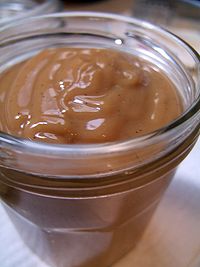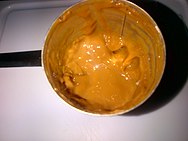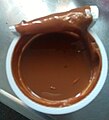 | |
| Alternative names | Caramelized milk, milk candy, milk jam |
|---|---|
| Type | Confectionery |
| Region or state | Latin America, Philippines, France, Poland |
| Main ingredients | Milk, sugar |
Dulce de leche (Spanish: [ˈdulse ðe ˈletʃe, ˈdulθe]), caramelized milk, milk candy, or milk jam is a confectionery popular in Latin America, France, Poland, and the Philippines prepared by slowly heating sugar and milk over several hours. The substance takes on a spreadable, sauce-like consistency and derives its rich flavour and colour from non-enzymatic browning. It is typically used to top or fill other sweet foods.
Since 1998, and at the initiative of the Argentine Center for the Promotion of Dulce de Leche and Related Products, International Dulce de Leche Day is celebrated every October 11.
Names and similar confections
Spanish dulce de leche and Portuguese doce de leite (Portuguese: [ˈdosi dʒi ˈlejtʃi]) mean "sweet of milk". Other names in Spanish include manjar ("delicacy"), arequipe and leche quemada ("burnt milk", a term popular in Mexico); also in Mexico and some Central American countries dulce de leche made with goat's milk is called 'cajeta'.
In the Philippines, dulce de leche made with carabao (water buffalo) milk is called dulce gatas, and is a specialty of Negros Occidental province.
In French, it is called confiture de lait (milk jam). In France, it is traditional in the regions of Normandy and Savoy, where it is commonly served with fromage blanc or crêpes.
The same confectionery is also known as kajmak in Polish cuisine, named after Turkish kaymak, a kind of clotted cream. Kajmak is most commonly used for wafers or the mazurek pie traditionally eaten at Easter.
History
There are various stories about its origin. Some reports say it originated in Indonesia in the 6th century. Later it would have being brought to the Philippines, Spain, and finally into Latin America. Apocryphal stories also suggest it was brought to the Americas by important historical figures like Napoleon or Argentinian general Juan Manuel de Rosas.
In 2003, Argentina attempted to declare dulce de leche as national patrimony but countries across South America and Central America objected due to its popularity all over the continent.
Preparation
| This article needs additional citations for verification. Please help improve this article by adding citations to reliable sources. Unsourced material may be challenged and removed. Find sources: "Dulce de leche" – news · newspapers · books · scholar · JSTOR (June 2022) (Learn how and when to remove this message) |
 Making dulce de leche in a rotating copper vessel, in Mexico
Making dulce de leche in a rotating copper vessel, in Mexico Consistency of dulce de leche made from boiling condensed milk in a can
Consistency of dulce de leche made from boiling condensed milk in a can
| Nutritional value per 100 g (3.5 oz) | |||||||||||||||||||||||
|---|---|---|---|---|---|---|---|---|---|---|---|---|---|---|---|---|---|---|---|---|---|---|---|
| Energy | 1,320 kJ (320 kcal) | ||||||||||||||||||||||
| Carbohydrates | 55.4 g | ||||||||||||||||||||||
| Sugars lactose | 49.7 g 4.92 g | ||||||||||||||||||||||
| Fat | 7.35 g | ||||||||||||||||||||||
| Saturated | 4.53 g | ||||||||||||||||||||||
| Monounsaturated | 2.14 g | ||||||||||||||||||||||
| Protein | 6.84 g | ||||||||||||||||||||||
| |||||||||||||||||||||||
| Other constituents | Quantity | ||||||||||||||||||||||
| Water | 28.7 g | ||||||||||||||||||||||
| Cholesterol | 29 mg | ||||||||||||||||||||||
Source: Estimates of USDA Food Nutrient Database | |||||||||||||||||||||||
| Percentages estimated using US recommendations for adults, except for potassium, which is estimated based on expert recommendation from the National Academies. | |||||||||||||||||||||||
The most basic recipe calls for slowly simmering milk and sugar, stirring almost constantly until the sugar dissolves (baking soda then can be added), after more constant stirring (between 1.5 – 2 hours) until the mixture thickens and finally turns a rich brown golden-brown colour.
Other ingredients such as vanilla may be added for flavor. Much of the water in the milk evaporates and the mix thickens; the resulting dulce de leche is usually about a sixth of the volume of the milk used. The transformation that occurs in preparation is caused by a combination of two common non-enzymatic browning reactions called caramelization and the Maillard reaction.
Another method of preparation, similar to Russian boiled condensed milk known as "varyonaya sgushchyonka", involves using canned or boxed sweetened condensed milk and cooking it in a pressure cooker for 20 to 25 minutes for a light color and slightly soft consistency, or 40 to 45 minutes for a darker color and firmer consistency. If using condensed milk from a box, it should be wrapped in about 5 to 6 layers of aluminum foil to prevent it from bursting.
It is also possible to place the condensed milk in a glass jar and boil it in the pressure cooker. In this method, different ingredients can also be added to the sweetened condensed milk, such as shredded coconut or peanuts. However, certain precautions need to be taken, such as wrapping the jar with a kitchen towel and lining the pressure cooker with another kitchen towel so that the bottom of the jar does not touch the cooker (as contact may cause the glass to shatter). The cooking time is similar to the previous method (around 35 to 40 minutes). Water should be added to the pressure cooker – enough to cover the cans, boxes, or jars of condensed milk. A small amount of vinegar can be added to the water in the pressure cooker to prevent it from becoming discolored at the bottom. In all cases, once ready, it is important to let the dulce de leche cool completely, which takes about 2 hours.
Use
Dulce de leche can be eaten alone, but is more commonly used as a topping or filling for other sweet foods, such as cakes, churros, cookies (see alfajor), waffles, flan cakes (aka crème caramel (known as pudim among Portuguese-speakers) (not to be confused with British pie-like variant of flan), fruits like bananas and candied figs, and ice creams; it is also a popular spread on crepes (panqueques), obleas (wafers), and toast.
Gallery
-
 Dulce de leche pot
Dulce de leche pot
-
 Muffins
Muffins
-
Crème caramel, a variant of a flan cake
-
 Banoffee pie
Banoffee pie
-
 Corn starch alfajor
Corn starch alfajor
-
 Dulce de leche roll
Dulce de leche roll
-
 Dulce de leche in glass jars
Dulce de leche in glass jars
-
 A can of condensed milk boiled for several hours to become varyonka, a dish similar to caramelized milk
A can of condensed milk boiled for several hours to become varyonka, a dish similar to caramelized milk
See also
- Baked milk – beverage derived from milk
- Banoffee pie – English dessert pie
- Basundi – Indian sweet
- Brunost – Norwegian cheese
- Caramel – confectionery product made by heating sugars
- Caramel candy – confectionery product made by heating sugars
- Crème caramel – custard dessert with soft caramel on top
- Condensed milk – milk from which water has been removed and sugar added
- Custard – semi-solid cooked mixture of milk and egg
- Krówki – Polish confectionery
- Manjar blanco – term used in Spanish-speaking area of the world in reference to milk-based delicacies
- Penuche – candy
- Russian candy – sweet toffee-like dessert
- Ryazhenka – fermented dairy beverage
- Sandesh – Bengali confectionery
- Teja
- Tres leches cake – dessert
Notes
- The term arequipe is used in Colombia and Venezuela, cajeta is used in Mexico, manjar or manjar blanco is used in Bolivia, Chile, Ecuador and Peru.
References
- ^ McSweeney, Paul L. H.; Fox, Patrick F. (20 April 2009). Advanced Dairy Chemistry: Volume 3: Lactose, Water, Salts and Minor Constituents. Springer Science & Business Media. ISBN 978-0-387-84865-5. Retrieved 13 February 2021.
- ^ McGee, Harold (2004). On Food and Cooking: The Science and Lore of the Kitchen. New York: Scribner. p. 657. ISBN 0-684-80001-2. Archived from the original on 28 July 2023. Retrieved 8 August 2012.
- Vargas García, Claudia (9 October 2023). "The diverse origin of dulce de leche". www.diariolechero.cl (in Spanish). Retrieved 15 December 2024.
- "Origen mítico del dulce de leche" [The Mythical Origin of Dulce de Leche] (in Spanish). Clarín. 6 April 2003. Archived from the original on 9 August 2016. Retrieved 8 June 2014.
- "Desilusión: el dulce de leche no fue un invento argentino" [Disappointment: dulce de leche was not an Argentine invention]. El Cronista (in Spanish). 23 September 2016. Archived from the original on 8 January 2024. Retrieved 8 January 2024.
- Tajanlangit, Eli F.J. (3 February 2012). "They're stealing our dulce gatas". The Visayan Daily Star. Archived from the original on 17 June 2024. Retrieved 8 January 2024.
- Robuchon, Joël (2001). Larousse Gastronomique. Octopus Publishing Group. ISBN 978-0-600-60688-8.
- "Polish Chocolate and Dulce de Leche Mazurek". Polish Your Kitchen. 9 April 2017. Archived from the original on 29 June 2021. Retrieved 27 February 2021.
- ^ Catherine Marshall, ed. (14 March 2023). "The origins of dulce de leche: The sweet treat that caused an international incident". The Sydney Morning Herald, 14 March 2023. Retrieved 6 October 2024.
- "FoodData Central". Archived from the original on 3 April 2019. Retrieved 13 December 2022.
- United States Food and Drug Administration (2024). "Daily Value on the Nutrition and Supplement Facts Labels". FDA. Archived from the original on 27 March 2024. Retrieved 28 March 2024.
- National Academies of Sciences, Engineering, and Medicine; Health and Medicine Division; Food and Nutrition Board; Committee to Review the Dietary Reference Intakes for Sodium and Potassium (2019). "Chapter 4: Potassium: Dietary Reference Intakes for Adequacy". In Oria, Maria; Harrison, Meghan; Stallings, Virginia A. (eds.). Dietary Reference Intakes for Sodium and Potassium. The National Academies Collection: Reports funded by National Institutes of Health. Washington, DC: National Academies Press (US). pp. 120–121. doi:10.17226/25353. ISBN 978-0-309-48834-1. PMID 30844154. Retrieved 5 December 2024.
- "Dulce de Leche". Food Network UK. Archived from the original on 28 October 2022. Retrieved 28 October 2022.
- ^ "Doce de leite na pressão". Panelinha (in Brazilian Portuguese). Archived from the original on 23 August 2023. Retrieved 8 June 2023.
- "Receita com apenas 2 ingredientes: doce de leite de panela de pressão". Receitas (in Brazilian Portuguese). Archived from the original on 23 August 2023. Retrieved 8 June 2023.
- ^ "Doce de leite em pote "Dulce de leche in a jar"". Archived from the original on 23 August 2023. Retrieved 8 June 2023.
- "Homemade dulce de leche with coconut and peanut paçoca" - DOCE DE LEITE ARTESANAL COM COCO,E PAÇOQUITA, 11 September 2019, archived from the original on 23 August 2023, retrieved 8 June 2023